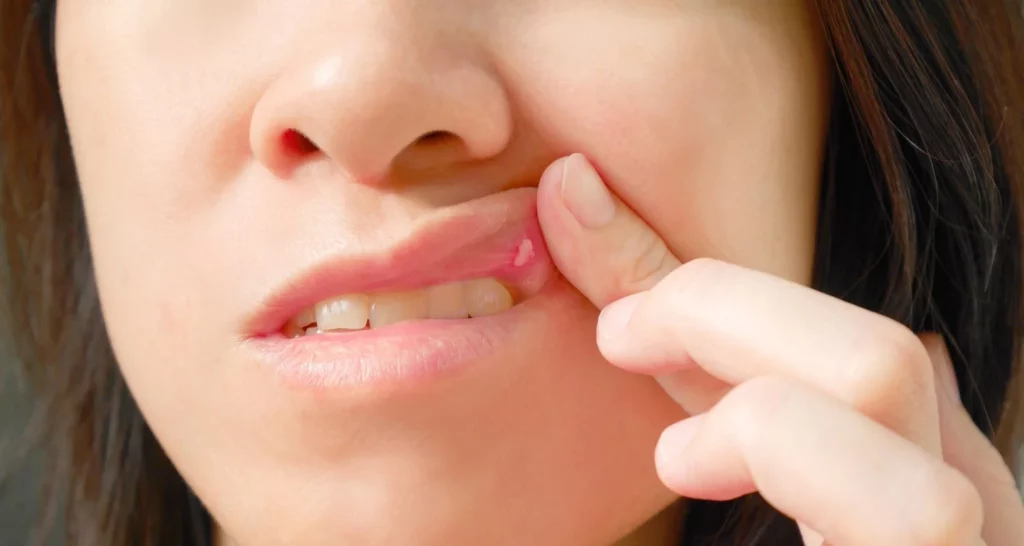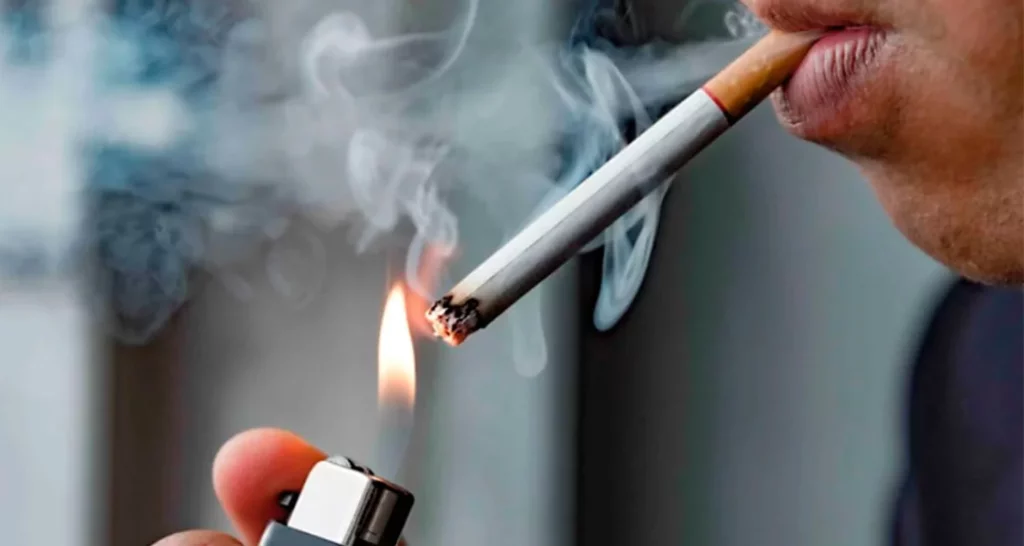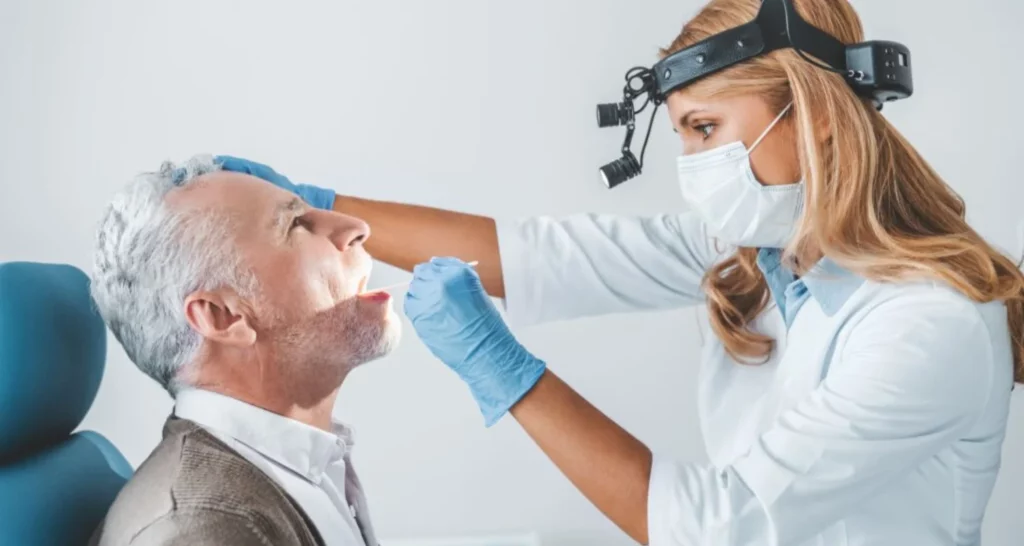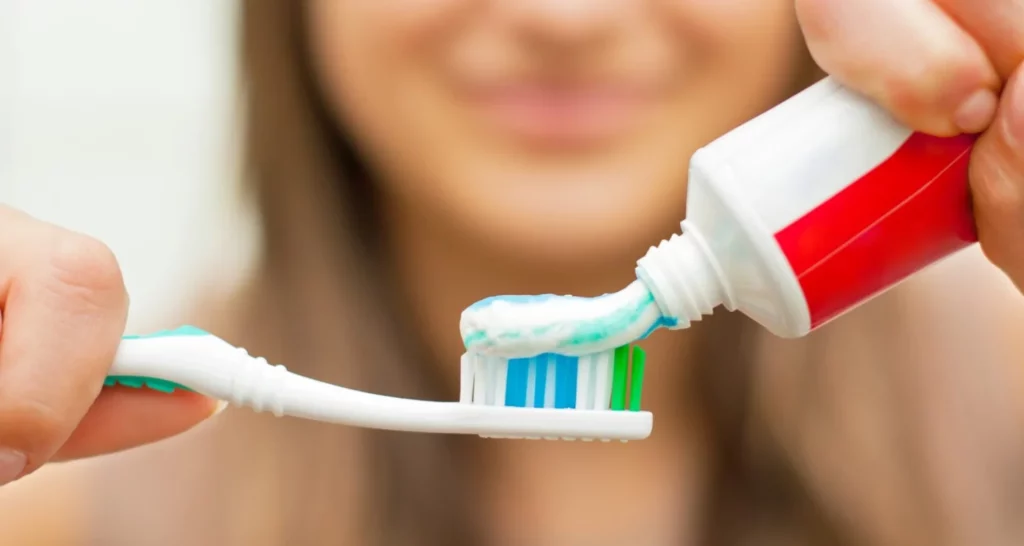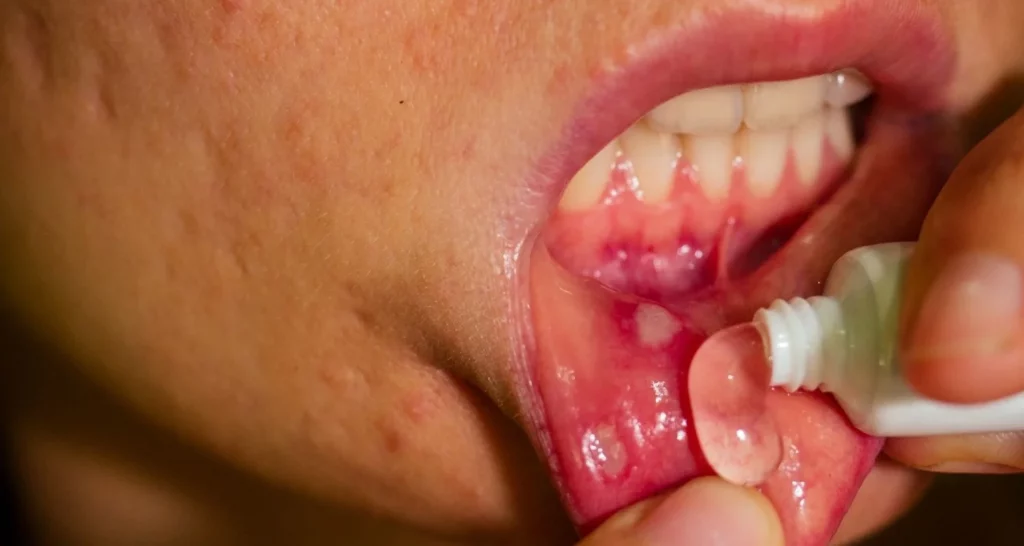Last Updated on: 18th December 2025, 11:03 am
Canker sores are ulcer-like lesions that appear inside the mouth, specifically in soft areas such as the cheeks, tongue, the base of the gums, and the inside of the lips; They are usually quite annoying and painful, but they are not contagious and heal on their own after a week or two.
If you want to learn about mouth ulcers, you can check the article here.
This article will explain the symptoms of canker sores, what Causes Canker Sores, how they are diagnosed, what care should be taken and if it is possible to prevent them.
What Causes Canker Sores?
Signs and symptoms of canker sores causes
What does a thrush look like?
They initially present as reddish lesions; then they acquire a whitish or yellowish color in the center, surrounded by bright red edges. When healing, they look grayish in the center.
What are the symptoms?
One or two days before a canker sore develops, a tingling or burning sensation may occur in the area where it will appear. They are painful and in some cases can cause fever and general malaise.
Classification
Canker sores are divided into 3 types:
● Minors: They are the most frequent, representing 80% of the cases. They are observed as small lesions measuring 2 to 5mm. They heal in one to two weeks and leave no scars.
● Greater: Large and deep lesions, very painful, measuring about 1 cm. They take up to 6 weeks to heal and may leave scars.
● Herpetiformis (recurrent aphthous stomatitis): They are uncommon and are seen as very small lesions, 1–2 mm in size, that clump together to form a large ulcer. They heal in one to two weeks without scarring.
What Causes Canker Sores? 10 Potential Causes
The main canker sores causes is unknown, but several factors can trigger them, such as:
1. Trauma: Injuring yourself while brushing, using braces or devices that cause rubbing on the soft tissues of the mouth, involuntary bites, among others.
2. Sensitivity to some foods: Chocolate, peanuts, cheese, tomato, cereals, among others.
3. Alteration of the immune system: Allergies.
4. Psychological alterations: Emotional stress, depression, anxiety, among others.
5. Adverse drug reactions: corticosteroids, immunosuppressants, antineoplastics, non-steroidal anti-inflammatory drugs, and anti-infectives.
6. Hormonal changes: During the menstrual cycle or pregnancy.
7. Habits: Tobacco use.
8. Nutritional deficiencies: Vitamin and mineral deficiency. For example, iron, vitamin C, zinc, folic acid, vitamin V12, among others.
9. Hereditary factors.
10. Diseases: For example, HIV behcet’s disease, inflammatory bowel disorders and Celiac Disease.
Thrush can be multifactorial, that is, due to a combination of various causes.
Diagnosis of the canker sores causes
An adequate diagnosis is necessary to determine the most effective treatment for canker sores in each case.
Initially, the dentist will take a medical history in which he or she inquires about the family and personal history, habits, systemic diseases, medical and pharmacological treatments of each patient. You will be asked questions about how long, you have the ulcers, if you have had them before, and if you have similar lesions in other parts of the body, among others.
Then during a clinical examination the dentist will evaluate the appearance of lesions, the size, shape, color and location. This is done to determine the causes canker sores, the type of lesions and make a differential diagnosis with other diseases, such as herpes virus simple, also known as a lip sore.
It is a disease caused by the type I herpes virus, and is usually presented as a group of small blisters filled with fluid. They occur outside the mouth near the lips and are extremely contagious.
Prevention of canker sores causes
Canker sores causes are recurrent, that is, they can reappear; but it is possible to reduce their frequency by following these recommendations:
● Good oral hygiene habits: Using a soft-bristled toothbrush, brush your teeth after each meal, floss at least once a day, and avoid mouthwashes that contain alcohol, as the sore can worsen.
● Eat healthy foods: Adopt a varied diet and eat fruits, vegetables, and foods rich in vitamin C and Omega 3.
● Reduce stress: Learn techniques to reduce stress and anxiety, through sports or meditation exercises.
● Protect the mouth: In case of using braces or other devices in the mouth, apply wax or ask the dentist if it is possible to reduce the friction of the device so it does not cause damage.
● Pay attention to food: Avoid consuming irritating, very salty, or hot foods and those to which you have allergies.
● Chew slowly.
When to visit the dentist
Canker sores causes do not normally pose a risk to general health; but in some cases it is advisable to visit the dentist:
● If a restoration is dislodged or fractured and when a prosthesis is broken or damaged so the dentist can treat the problem before a lesion appears.
● Unusually large lesions.
● Very recurrent lesions that appear more than 2 or 3 times a year.
● Canker sores that remain for more than 2 weeks.
● Canker sores that extend to the lips, that is, lesions inside and outside the mouth.
● Intense pain.
● Difficulty eating, drinking, or brushing teeth.
● Fever, diarrhea, or headache.
Treatment
Canker sores usually go away on their own after 2-3 weeks; Recommendations can be followed at home, such as using rinses or gels; and in some cases apply topical medications or ingest them orally. The topic is presented in depth on our website with the different treatment options and recommendations explained.
Conclusion
In conclusion, canker sores are non-contagious, painful lesions that form inside the mouth on soft tissues like the cheeks, tongue, gums, and lips. They start as reddish spots that turn whitish or yellowish with red edges and heal within 1-2 weeks. Symptoms include a tingling or burning sensation before the sore appears, pain, and sometimes fever.
The exact canker sores causes is unknown, but triggers include oral trauma, food sensitivities, immune issues, stress, certain medications, hormonal changes, tobacco use, nutritional deficiencies, heredity, and diseases. Diagnosis involves a medical history and clinical examination by a dentist.
Preventing canker sores involves good oral hygiene, a healthy diet, stress management, and avoiding irritant foods. Visit a dentist for large, persistent, or frequently recurring sores, or if complications arise. Treatment typically includes home remedies and medications. For detailed treatment options, refer to our website.
Frequently Asked Questions
What are canker sores?
Canker sores are painful lesions that form inside the mouth, typically healing within 1-2 weeks. Symptoms include tingling before the sore, pain, and sometimes fever.
What causes canker sores?
The exact cause is unknown, but triggers include oral trauma, food sensitivities, stress, and certain medications.
How are canker sores diagnosed?
Dentists diagnose canker sores based on a medical history and clinical examination.
How can I prevent canker sores?
Practice good oral hygiene, eat a balanced diet, manage stress, protect your mouth from irritation, and avoid trigger foods.
When should I see a dentist about a canker sores?
See a dentist for unusually large or persistent sores, sores that spread to the lips, severe pain, fever, or a broken restoration.
Share:
References
1. Canker sores and cold sores. (2005). The Journal of the American Dental Association, 136(3), 415. https://doi.org/10.14219/jada.archive.2005.0185
2. Canker sore. (reviewed Jun 6, 2021). MedlinePlus. https://medlineplus.gov/ency/article/000998.htm
3. Canker Sore (Aphthous Ulcer). (July 11, 2005). WebMD. https://www.webmd.com/oral-health/guide/canker-sores
4. Canker Sore (Aphthous Ulcer): What It Is, Causes & Treatment. (s. f.). Cleveland Clinic. https://my.clevelandclinic.org/health/diseases/10945-canker-sores
5. Canker sores (mouth ulcers): Overview. (August 15, 2019). Institute for Quality and Efficiency in Health Care. Updated: 2022. https://www.ncbi.nlm.nih.gov/books/NBK546250/
6. Canker sore – Symptoms and causes. (April 3, 2018). Mayo Clinic. https://www.mayoclinic.org/diseases-conditions/canker-sore/symptoms-causes/syc-20370615
7. Fever Blisters & Canker Sores. (s. f.). National Institute of Dental and Craniofacial Research. https://www.nidcr.nih.gov/health-info/fever-blisters-canker-sores
8. Kahn, A. (December 2, 2021). Painful Sensation? Could Be a Canker Sore. Healthline. https://www.healthline.com/health/canker-sores
9. MacGill, M. (June 9, 2017). Everything you need to know about canker sores. Medical news today. https://www.medicalnewstoday.com/articles/303311
-
Nayibe Cubillos M. [Author]
Pharmaceutical Chemestry |Pharmaceutical Process Management | Pharmaceutical Care | Pharmaceutical Services Audit | Pharmaceutical Services Process Consulting | Content Project Manager | SEO Knowledge | Content Writer | Leadership | Scrum Master
View all posts
A healthcare writer with a solid background in pharmaceutical chemistry and a thorough understanding of Colombian regulatory processes and comprehensive sector management, she has significant experience coordinating and leading multidisciplina...



